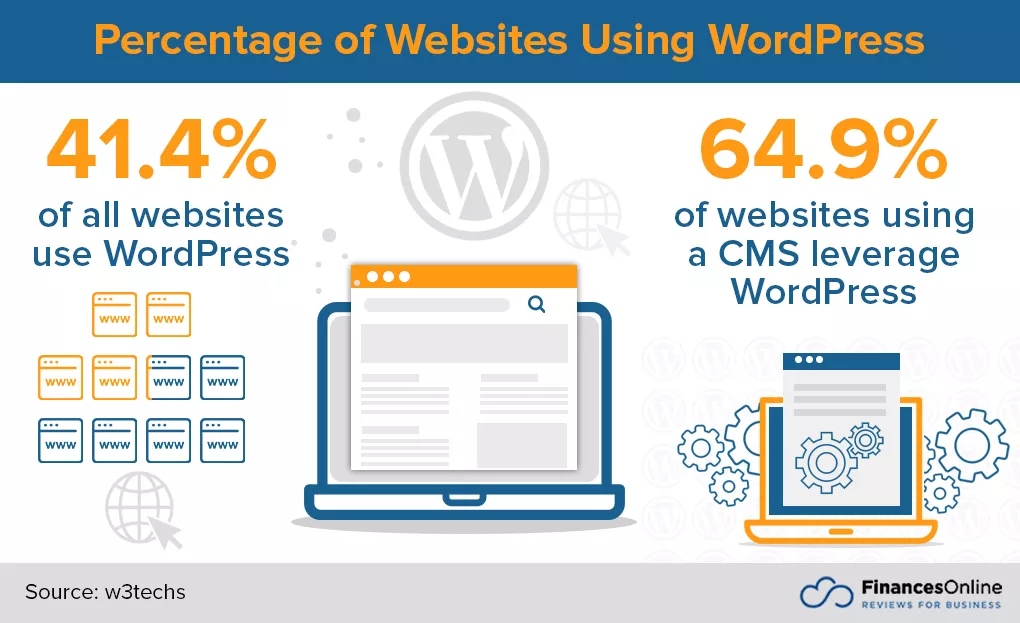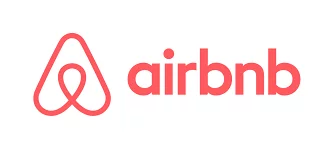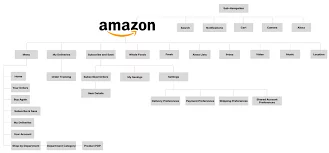WordPress, powering over 40% of the web, is the platform of choice for businesses and individuals. As Matt Mullenweg, the co-founder of WordPress, succinctly puts it, “WordPress is a platform that enables you to achieve, not a bunch of features.”
In today’s digital landscape, where websites play a pivotal role in businesses’ success, mastering WordPress project management is not just a skill; it’s a competitive advantage. As WordPress continues to dominate the web, managing projects efficiently becomes a game-changer.
According to recent statistics, WordPress powers over 41% of all websites. Its flexibility, scalability, and extensive ecosystem of themes and plugins make it the platform of choice for businesses and individuals alike. However, the sheer volume of WordPress-powered websites also means fierce competition.

Whether you’re a freelancer navigating the intricacies of client projects, part of a web development agency juggling multiple WordPress sites, or simply passionate about leveraging WordPress’s capabilities, this blog is your ticket to staying ahead. We’re here to equip you with the latest insights, proven strategies, and industry secrets to empower you to excel in WordPress project management.
Strategies for Effective WordPress Project Management:
1. Determine core goals for your site

One of the critical initial steps when embarking on creating a WordPress website is the identification of the fundamental objectives for your site. Once you clearly understand your aim, you can streamline your choices and chart the most suitable path forward. Here are several factors to contemplate when defining the purposes of your website:
- What is the intended achievement of the site? Clarify the primary outcomes you desire from your website.
- Who constitutes your target audience? Identify the specific group of people you intend to cater to or engage with through your site.
- What type of content will be essential to fulfill your objectives? Determine the content genres and formats necessary to attain your predefined goals.
Addressing these inquiries will facilitate the development of a well-directed and efficient website. Remembering to precisely understand your goals can lead to staying focused on your ultimate objectives. Thus, allocating time to delineate your core goals is imperative before initiating your WordPress project.
EXAMPLE:

When Airbnb started, it had a clear goal: connecting travelers with unique, local accommodations. Before delving into the development of their website, they addressed the critical questions mentioned:
1. Intended Achievement: Airbnb aimed to revolutionize the travel industry by providing a platform for individuals to list and book accommodations, not just in traditional hotels but in local homes, apartments, and unique spaces. Their primary objective was to create a marketplace that would make travel more personalized, affordable, and authentic.
2. Target Audience: Their target audience comprises travelers seeking unique and cost-effective accommodations and individuals looking to monetize their extra space by becoming hosts. This dual focus on hosts and travelers was essential for Airbnb’s success.
3. Content Strategy: To fulfill its goals, Airbnb needed a content strategy that included high-quality property listings with detailed descriptions, photographs, and reviews. They also emphasized user-generated content, where hosts and guests contributed to the platform’s content by sharing their experiences and recommendations.
2. Create a site map

Crafting a comprehensive site map is a pivotal undertaking in website development. Through this endeavor, you can meticulously chart your site’s overall layout and navigation. This proactive approach to site planning yields long-term benefits, imparting a clear roadmap for your website’s construction.
A site map is a valuable tool for organizing the content in your web design. By devising your website’s hierarchy, you ensure that users can effortlessly locate and browse your content. This facet becomes particularly critical for sprawling websites featuring an abundance of materials.
Moreover, the site map serves a dual role by establishing priorities and design parameters for each page, thus streamlining the development process. Equally significant is its contribution to search engine optimization, as search engine crawlers, such as those employed by Google, can efficiently index your site, enhancing its visibility on search engine result pages (SERPs).
The efficiency with which these crawlers glean information from your site map profoundly influences Google’s assessment of your website’s relevance.
Here are some recommendations for crafting an exemplary site map:
- Conceptualize Website Structure: Gain a lucid understanding of how you envision your website’s structure. This mental framework will facilitate the initial drafting process. From this blueprint, you can ascertain the primacy of specific pages and envision their design. Essential pages such as the homepage, about page, and product pages merit top-tier prioritization.
- Sequential Prioritization: Initiate your site map by commencing with the introduction and systematically attending to the most critical pages. An organized approach to mapping is paramount. Not only does logical structuring enhance user navigation, but it also expedites search engine indexing, bolstering the prospect of securing higher rankings in search results. Elevating your premier content to the upper tiers of the site’s architecture expedites indexing and augments your website’s ranking.
EXAMPLE:

A real-life example illustrating the importance of a well-structured site map is the e-commerce giant Amazon. Amazon’s website is a vast and complex platform with an extensive range of products, services, and features. Crafting a practical site map played a significant role in their success.
- Conceptualizing Website Structure: Amazon began with a clear understanding of how they wanted their website’s structure to look. They envisioned a multi-tiered approach, with a homepage as the gateway to various departments (e.g., electronics, books, clothing) and individual product pages. Their mental framework allowed them to prioritize critical pages, such as the homepage and product category pages, ensuring these were easily accessible to users.
- Sequential Prioritization: Amazon’s site map is meticulously organized. They prioritize key pages like the homepage, product listings, and search functionality at the top of their hierarchy. This logical structuring enhances user navigation and expedites search engine indexing. When users search for products on Amazon, the site map helps search engine crawlers quickly index and rank relevant product pages, leading to higher visibility in search results.
3. Define the functionality required

Before commencing any WordPress project, it is crucial to allocate some time to delineate your website’s required functionality. This understanding will be invaluable in selecting appropriate plugins and themes, ensuring your site adequately caters to its users.
Several considerations should be taken into account. Firstly, contemplate the overarching purpose of your website. Are you aiming to establish a straightforward blog or a more intricate platform with e-commerce capabilities? Once the primary purpose has been identified, you can proceed to pinpoint the specific features that will be essential.
For instance, if your website is geared towards online retail, installing the WooCommerce and BuddyPress plugins on your WordPress platform is advisable. These plugins grant access to shopping carts, checkout procedures, and coupon add-ons. Additionally, incorporate social media application integrations to foster interaction between customers and clients or employ drag-and-drop functionality to facilitate task tracking on your project page.
Furthermore, take into consideration your target audience. Who will be visiting your site, and what are their expectations? There are several methods to identify your potential user base, including the following strategies:
- Keyword Analysis: Delve into keyword analysis to unearth and evaluate the search terms that potential customers use to seek products or services similar to yours. Once you have identified the primary keywords related to your offerings, narrow them down by geographical regions. Google Trends can provide valuable insights into keyword trends, shedding light on user behavior.
- Social Analytics Tools: Another effective method for pinpointing your target audience is to monitor social media conversations. Keep an eye on hashtags and trends pertinent to your industry to gain insights into what people discuss regarding your business and competitors. Additionally, analyze descriptive terms that your audience employs to articulate their service needs, such as “easy,” “better,” “fast,” and more.
- Competitor Analysis: Analyzing other businesses within your industry can offer valuable insights into your target audience. Start by examining top review sites, such as G2 or TrustRadius, to understand your competitors’ customer base demographics and what aspects of the service make them content. Peruse your competitors’ blogs to glean further insights into their audience and the types of solutions that pique their interest. Specialized target audience research tools like Semrush and SpyFu can provide in-depth analysis of competitor keywords and their target market.
- Surveys and Interviews: Utilize surveys and interviews as effective tools for data collection. Platforms like SurveyMonkey and Google Forms offer free tools for creating surveys. Pose questions to respondents that reveal their interests, behaviors, and pain points about your business. For example, in a coffee-related survey, you could inquire about the frequency of coffee consumption and whether respondents would prefer coffee delivery services. Include demographic inquiries covering age, gender, occupation, and location. Expanding the reach of your survey to a broader audience helps reduce the margin of error in your findings.
EXAMPLE:

Before launching its online streaming service, Netflix started as a DVD rental-by-mail service. However, they recognized the shifting media consumption landscape and aimed to transition into a digital platform. To do this, they had to determine their website’s functionality accurately. Their primary goal was to provide users with a seamless and personalized streaming experience.
Netflix invested in developing a user-friendly website with features like a recommendation engine, user profiles, and a robust content delivery system. These functionalities were critical in making their platform stand out in the crowded streaming market.
Identifying Target Audience: Netflix recognized that its target audience included a broad spectrum of viewers, from individuals looking for family-friendly content to those interested in niche genres. They conducted extensive market research to understand their potential users’ diverse preferences and needs
Research Methods:
- Keyword Analysis: Netflix employs keyword analysis to understand what users search on their platform. They can determine which content to prioritize and create by analyzing search queries and trending keywords.
- Social Analytics Tools: Netflix actively monitors social media conversations, trending hashtags, and discussions about their original content and competitors. This helps them gauge audience sentiment and adjust their content strategy accordingly.
- Competitor Analysis: Netflix studies its competitors, such as Amazon Prime Video and Hulu, to stay ahead in the streaming industry. They analyze user reviews, ratings, and feedback to identify areas where they can outperform their rivals.
- Surveys and Interviews: Netflix conducts surveys and interviews with their subscribers to gain insights into their viewing habits, content preferences, and pain points. They use this data to refine their content offerings and user experience continually.
4. Choose a domain name

Selecting a domain name and WordPress hosting service might appear minor steps, but they are pivotal when embarking on your web development journey. Your domain name serves as your website’s online address, while your web hosting service is the repository for your website’s files.
A well-chosen domain name and web hosting service play a crucial role in setting your website apart from others and facilitating easy discovery and access by visitors.
What constitutes a quality domain name is defined as follows:
- Keep it concise: Google recommends a domain name consisting of two to three words, making it effortless for users to type and remember. Avoid lengthy and convoluted phrases.
- Incorporate brand or keywords: Including your brand name or relevant keywords in your domain name can enhance your search engine optimization (SEO) efforts. A domain name that aligns with your business and contains relevant keywords can boost your rankings on search engine results pages (SERPs). For instance, a cleaning service website might append “cleaning” to the domain name or include a location identifier like “Denver.”
- Consider affordability: Domain name prices vary widely based on the current owner, competition, and name popularity. It’s wise to explore options within your long-term budget when searching for domain names.
EXAMPLE:

A real-life example that underscores the significance of selecting an appropriate domain name and web hosting service is the popular ride-sharing platform Uber.
Domain Name: When Uber started, it recognized the importance of a concise and memorable domain name. They chose “uber.com,” a domain consisting of just four letters. This succinct and easily remembered domain name aligned perfectly with their vision of a hassle-free and convenient ride-sharing service. It adhered to Google’s recommendation of a short and memorable domain name, making it effortless for users to type and recall.
Incorporating Brand or Keywords: Uber’s choice of domain name also subtly incorporated brand elements. While “uber” doesn’t explicitly describe its service, it has become synonymous with convenient transportation. Moreover, they wisely chose a name that avoided geographical limitations. Instead of using a location-specific name like “DenverRides,” they opted for a more versatile name, allowing them to expand globally without changing their domain.
Consider Affordability: Although the specific cost of “uber.com” is not publicly disclosed, it’s safe to assume that Uber, a forward-thinking tech company, made a reasonable investment in acquiring this domain. They recognized the long-term value of a short, brandable domain name that could serve as a global online address for their service.
Web Hosting Service: In addition to their domain name choice, Uber also made strategic decisions regarding their web hosting service. They opted for reliable and scalable hosting to ensure their platform could handle rapid growth and provide a seamless experience to users worldwide. This decision was critical in supporting their global expansion and accommodating millions of users.
5. Consider your web hosting options

Selecting the right web hosting provider for your WordPress website is a crucial decision that hinges on several key factors. Web hosting involves leasing server space from a company to make your website accessible on the internet. Besides storage, hosting services may offer features like databases, bandwidth, security certificates, firewalls, and more.
Web hosting generally has three main types: shared, managed, and self-hosted.
1. Shared Hosting: This is the most budget-friendly option, where you share server resources with other users. While cost-effective, it means you rely on other users’ behavior on the same server. If they consume excessive resources, it could impact your site’s performance.
2. Managed Hosting: Although pricier than shared hosting, managed hosting provides more control over your server. The hosting provider handles technical aspects, allowing you to focus on your website’s content and business operations.
3. Self-Hosting: This is the most expensive and hands-on option. With self-hosting, you have full control over your server and its technical details. This setup suits those with technical expertise and want complete control over their hosting environment.
For many small businesses, shared web hosting is a practical choice due to its affordability and user-friendliness. It eliminates the need to manage intricate technical aspects of the server.
Once you’ve determined the type of hosting that suits your needs, several other considerations should influence your decision:
- Uptime Guarantee: Inquire about the hosting provider’s uptime guarantee. Reliability and minimal downtime are critical for a successful website.
- Security Measures: Ask about the security measures to safeguard websites hosted on their servers. This includes firewalls, intrusion detection, and malware scanning.
- SSL Certificate: Determine if the hosting provider offers a free SSL certificate, which is essential for securing data transmission on your website.
- Compatibility with WordPress: Ensure that the hosting provider is compatible with WordPress. Additionally, confirm support for PHP and MySQL, as WordPress relies on these technologies.
By addressing these questions and considerations, you can make an informed decision when selecting a web host that aligns with your WordPress website’s requirements. Careful consideration of these factors will contribute to your online presence’s long-term success and reliability.
Consider choosing Nestify as your trusted hosting partner, powered by its own CDN for blazing fast performance.
7. Develop content for your website

Your website serves as the initial impression for most visitors to your business, making it crucial to establish a unique and memorable interface. The content, comprising the text on your website, plays a pivotal role in conveying your business’s message and inspiring action among your visitors. In essence, your web copy functions as the salesperson for your business, targeting potential customers effectively.
To craft exceptional copy for your website’s landing page, homepage, and other key pages, consider the following components:
- Compelling Header: A captivating header increases visitors’ likelihood of engaging with your copy. Keep it concise, direct, and imbued with a personal touch. Bonus points are awarded for incorporating relevant keywords into your header.
- Structured Copy: Follow the header with a well-structured description that informs readers about your product’s value and why they need it. Employ the AIDA model—Awareness, Interest, Desire, and Action—to guide your writing.
- Compelling Call to Action (CTA): The CTA is a cornerstone of persuasive copy. It should provide clear direction to readers, guiding them toward specific actions. Ensure that the copy on these pages maintains high quality to facilitate readers’ progression through the sales funnel.
- Descriptive Titles and Keywords: Incorporating relevant keywords into your page titles and content aids search engines in indexing your pages effectively. Utilize various methods to identify pertinent keywords, such as paid tools like SEMrush and Ahrefs or free tools like Google Analytics. Additionally, monitoring the “Search Related Topics” section of Google search results offers insights into popular keywords.
- Engage a Web Designer: Responsive web design is a core responsibility of web designers. These professionals can enhance your site’s architecture or construct one from the ground up. Since publishing your site map in HTML or XML files is essential, seeking expert assistance from a web designer can eliminate unnecessary errors. Platforms like Upwork provide opportunities to hire skilled web designers for your project.
EXAMPLE:

A real-life example that highlights the importance of crafting exceptional website copy and engaging a web designer is the online streaming platform Spotify.
- Compelling Header and Structured Copy: When you land on Spotify’s homepage, you’re greeted with a compelling header: “Music for everyone.” This concise and inclusive statement immediately conveys their message – that they offer music for a wide audience It addresses the AIDA model by creating awareness of their service, sparking interest with personalized playlists, arousing desire through tailored music recommendations, and culminating in a clear call to action to “Download Spotify” or “Get Spotify Free.”
- Compelling Call to Action (CTA): Spotify’s CTAs are strategically placed throughout their website. Whether you’re on the homepage or a landing page for a specific subscription plan, the CTAs are clear and action-oriented, directing users to “Sign Up Free” or “Get Spotify Premium.” These CTAs guide users through the conversion funnel, facilitating their journey from discovery to subscription.
- Descriptive Titles and Keywords: Spotify’s website is optimized for search engines. Their page titles and content incorporate relevant keywords like “music streaming,” “playlists,” and “offline listening,” making it easier for users to find them in search results. By doing so, Spotify ensures that potential users looking for music streaming services are more likely to discover their platform.
8. Build a consistent brand image and style

Your website is one of the paramount marketing tools at your disposal, serving as the initial destination for potential customers seeking insights into your company and its offerings. Therefore, ensuring that your website impeccably reflects your brand’s identity is of utmost importance.
Consistency emerges as a linchpin in crafting a robust brand image. Your goal is for prospective customers to recognize your website as an embodiment of your company instantly. This can be accomplished by meticulously adhering to a uniform color scheme, font selection, and overall design style across all your marketing collateral. This encompasses brochures, business cards, flyers, posters, logos, and billboards.
Presenting your marketing materials with a unified tone and visual style facilitates a deeper understanding of your brand, giving you a competitive edge. However, to achieve and maintain brand consistency, certain steps must be taken:
- Create a Brand Identity Guide: This comprehensive handbook encompasses vital information about your brand, encompassing tone, color palette, visual style, logo usage, and typography guidelines. For instance, consider the emotional impact of colors and tone on your audience. To ensure your brand guide accurately represents your business, you may even consider enlisting the expertise of a brand identity designer through platforms like Upwork.
- Implement Your Guidelines: Once your identity guidelines are in place, meticulous execution is imperative at every point of interaction between your brand and customers. Whether you employ flyers, emails, billboards, or video advertisements, consistency in tone is paramount. To ensure that your marketing and design teams consistently employ the correct assets when creating content, utilizing an asset management tool such as BuzzSumo and Content Studio can be invaluable.
- Content Scheduling: Employing a marketing calendar becomes indispensable in managing your campaign schedules. It facilitates the seamless coordination of content distribution, ensuring a uniform message across all campaign facets. Advanced planning allows a comprehensive review of all materials to guarantee alignment with your brand identity. Consider using content scheduling plugins like Hootsuite, Buffer, or CoSchedule to streamline your content distribution efforts.
EXAMPLE:

Consistency has been a linchpin in Apple’s branding strategy. The goal is for prospective customers to instantly recognize the Apple website as a true embodiment of the company. Apple meticulously adheres to a uniform color scheme, font selection, and overall design style not only on its website but across all its marketing collateral, including brochures, business cards, flyers, posters, logos, and billboards.
By presenting its marketing materials with a unified tone and visual style, Apple has facilitated a deeper understanding of its brand. This consistency has given Apple a significant competitive edge, as customers and potential customers can easily identify and connect with the brand’s image, values, and products, whether they are visiting the website, reading a brochure, or encountering a billboard. Apple’s commitment to consistency has undoubtedly played a pivotal role in its continued success and strong brand recognition.
9. Get familiar with WordPress themes and plug-ins

WordPress stands out for its exceptional flexibility, allowing you to precisely tailor your website to your unique needs. Two key elements, WordPress themes and plug-ins, play pivotal roles in achieving this high level of customization.
Themes: Themes serve as the architects of your website’s aesthetics, defining its visual identity. They dictate color schemes, fonts, layouts, backgrounds, typography, and other design elements. Whether you aim for a captivating homepage or a consistent look throughout your site, themes provide the means to achieve it.
Plug-ins: On the other hand, plug-ins empower you to enhance your website’s functionality. These versatile tools inject new features into your site, expanding its capabilities. Whether you’re looking to integrate social media, create feedback forms, or revamp layouts, the WordPress plug-in directory offers numerous options to fulfill your needs.
Noteworthy Plug-ins: Among the multitude of plug-ins, several stand out for their utility:
- Yoast SEO: This plug-in is a comprehensive SEO toolkit, automating XML site map generation, seamlessly integrating with Google Analytics, and offering a built-in keyword research tool. Its user-friendly drag-and-drop interface and bulk editing capabilities simplify web development.
- JetPack: JetPack is a versatile toolkit encompassing essential features for social media integration, security, and web performance optimization. It serves as a Swiss Army knife for website owners looking to bolster their online presence.
- Project Management Plug-ins: For efficient project management, consider options like CoSchedule and WP Project Manager. These tools facilitate tracking deadlines, managing team members, coordinating calendars, and organizing schedules.
10. Prepare Blog Content for Your Website

Even if you don’t identify as a blogger, there are compelling reasons to consider crafting blog content before constructing your WordPress website. Blog content is a potent tool for drawing organic traffic to your site, establishing your authority in your industry, and positioning yourself as an expert. Moreover, it can be pivotal in lead generation and sales conversion.
Developing content for your website serves as an excellent starting point for your online presence and audience cultivation. Prioritize creating well-crafted, informative content that resonates with your target audience and is easily navigable. To simplify this task, consider enlisting the services of a professional blog writer through platforms like Upwork., and driving leads and sales. Let’s delve deeper into why this strategy matters.
Why Create Blog Content Early:
1. Attract Organic Traffic: High-quality blog content can serve as a magnet for organic search traffic. When you publish informative and valuable content, search engines like Google recognize your website as a reputable source, potentially leading to higher rankings in search results.
2. Establish Thought Leadership: Blogging allows you to share your expertise and insights within your industry. By consistently delivering valuable content, you can position yourself as a thought leader and gain the trust of your audience.
3. Generate Leads and Sales: Well-crafted blog posts can subtly promote your products or services, driving potential customers to take action. You can lead them toward conversion by addressing their pain points and offering solutions in your content.
11. Optimize Your WordPress Website for SEO Success

When constructing your WordPress website, prioritizing search engine optimization (SEO) is crucial. SEO enhances your website’s visibility and ranking on search engine results pages, ultimately driving more organic traffic and potential customers to your site. Explore effective ways to optimize your WordPress website for SEO and examine a real-world success story.
- Select an SEO-Friendly WordPress Theme: Start by choosing a WordPress theme that offers fast page load speeds and mobile-friendliness. A theme optimized for SEO provides a solid foundation for improving your website’s search engine rankings.
- Leverage SEO Plugins: WordPress offers a variety of SEO plugins to simplify and enhance your optimization efforts. Some popular options include Yoast SEO, All in One SEO Pack, and SEOPressor. These plugins provide valuable tools and guidance for optimizing your content, meta tags, and overall SEO strategy.
- Keyword Research: Utilize keyword research tools like Google Trends and Semrush to identify relevant keywords for your website. These tools help you understand your target audience’s search terms, allowing you to tailor your content accordingly.
EXAMPLE:

HubSpot, a leader in inbound marketing and content management, places a high emphasis on SEO optimization. When constructing their WordPress website, they chose a theme that looked appealing and optimized for SEO. The theme they selected was fast-loading, responsive across various devices, and designed to ensure a seamless user experience. This choice laid a solid foundation for their SEO efforts.
- Leveraging SEO plugins: HubSpot recognized the importance of utilizing SEO plugins to streamline their optimization efforts. They integrated the Yoast SEO plugin into their WordPress site. Yoast SEO is renowned for providing comprehensive SEO tools and guidance. HubSpot used this plugin to optimize their content, meta tags, and overall SEO strategy. By leveraging the features offered by Yoast SEO, they ensured that their content was search engine-friendly and adhered to best practices in SEO.
- Keyword Research: HubSpot’s content marketing and SEO success is closely tied to their diligent keyword research. They used tools like Semrush to identify relevant keywords for their blog posts, landing pages, and other content. By understanding the search terms their target audience used, they created content that specifically addressed these topics and met the needs of their audience.
Conclusion:
Effective project management is essential for the success of WordPress projects. By implementing these strategies and addressing common challenges, you can increase the likelihood of delivering high-quality WordPress websites on time and within budget. Regularly reviewing and adapting your project management approach will help you refine your processes and achieve better results in future projects.
FAQs on Project Management Strategies:
How can I effectively manage remote WordPress development teams?
Utilize collaboration tools, maintain clear communication channels, set expectations, and establish regular check-ins to ensure remote teams stay aligned with project goals.
How do I handle scope changes during a WordPress project?
Discuss scope changes with the client, evaluate their impact on the project timeline and budget, and document the changes in a formal scope change request. Get client approval before proceeding.
How do I ensure the security of a WordPress project?
Ensure WordPress and its plugins/themes are regularly updated, use strong passwords, implement security plugins, and conduct security audits. Also, follow best practices for secure coding.



